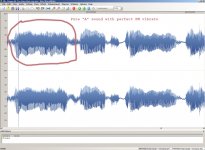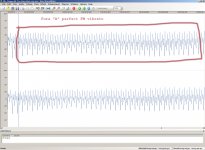Yes, that's how people used to receive this FM [...]
Getting back to audio, is the worry that a system with bandwidth limitations could convert the vibrato on the umpteenth harmonic of a soprano's voice into tremolo? That will indeed happen to some extent, but it will happen in any system with a bandwidth limitation. The ears of the listener, for example.
Regarding audio, one only has to remember that pitch change of the human voice can convey nonverbal intention / meaning hence human hearing is very sensitive to that (and related effects). Nonlinear effects of human hearing system could imply that someone with 10 KHz upper limit nevertheless can differentiate between a sound source providing up to 20 KHz and one limited 10 KHz, because of the generated IM products.
So how do the "digital makes you sick" advocates explain the opposite effect when it occurs?!
As a kid growing up, listening to vinyl because that's all there was, there were entire categories of music that I found too stressful to listen to because of all the clicks & pops, cartridge mistracking, inner groove distortion and everything else constantly jarring me out of the moment. And I'm not exaggerating here - Orchestral, piano, organ, acoustic guitar - I pretty much skipped this stuff because it was just too damn noisy and unmusical on vinyl. As soon as CDs began to appear, I was like a kid in a candy store, able to enjoy all this wonderful music for the first time! And it's only gotten better - my current audio rig is as digital as it can be, and is also the most natural, organic-sounding, stress-free setup I've ever owned, by a wide margin.
What utter poppycock.
As a kid growing up, listening to vinyl because that's all there was, there were entire categories of music that I found too stressful to listen to because of all the clicks & pops, cartridge mistracking, inner groove distortion and everything else constantly jarring me out of the moment. And I'm not exaggerating here - Orchestral, piano, organ, acoustic guitar - I pretty much skipped this stuff because it was just too damn noisy and unmusical on vinyl. As soon as CDs began to appear, I was like a kid in a candy store, able to enjoy all this wonderful music for the first time! And it's only gotten better - my current audio rig is as digital as it can be, and is also the most natural, organic-sounding, stress-free setup I've ever owned, by a wide margin.
What utter poppycock.
It is telling enough that whenever you ask the question - but does digitized music make you sick? How do you know?' that is never addressed.
Instead, the new posts are coming up, wavering all over the place, more like a demonstration of 'look how many things I know about', carefully avoiding ever replying to any pertinent question.
Just throwing up some random stuff and then rely on smoke screens for getting away. A disgrace to diyaudio and its members.
Jan
Instead, the new posts are coming up, wavering all over the place, more like a demonstration of 'look how many things I know about', carefully avoiding ever replying to any pertinent question.
Just throwing up some random stuff and then rely on smoke screens for getting away. A disgrace to diyaudio and its members.
Jan
Regarding audio, one only has to remember that pitch change of the human voice can convey nonverbal intention / meaning hence human hearing is very sensitive to that (and related effects).
I'm very sensitive to the Australian question intonation, which has spread like a cancer all over the world. So sensitive in fact that I quite often find myself saying in response, "I don't know, is it?", to which the usual reply is " What the f*** you on about mate", then I often say, " I'm sorry, I thought you asked me a question", as you can imagine the intercourse rapidly becomes non-verbal....
Apparently a number of cultures lay claim to it, can't imagine why. It's what we Brits call it and I remember Clive James defining it during one of his shows
I blame DiyA for that [digitization]
I had the enlightenment during the 2 minute server maintenance, when space age pictures are displayed. It's all about mainframes, monitors...
For me it's all about the miniskirts. 😱)
Electronic currents are comprised of FINITE numbers of electrons moving in random directions but with a net unidirectional drift. In the case of AC, the drift is bidirectional. The electrons' random motions gives rise to randomly changing electron densities that result in random voltages being set up. This is thermal noise which also adds its own ever changing harmonics.
In the wild, animal brains had to cope with simultaneous audible stimuli, sounds, and be capable of selectivity. This is important for survival; an animal has to be capable of recognizing sounds from a predator in order to survive and be capable of reproducing.
I am writing this to show that extra unwanted sounds, harmonics, should not be an issue as this has been dealt with in such a way as being filtered off, as is the case of selectivity.
In the wild, animal brains had to cope with simultaneous audible stimuli, sounds, and be capable of selectivity. This is important for survival; an animal has to be capable of recognizing sounds from a predator in order to survive and be capable of reproducing.
I am writing this to show that extra unwanted sounds, harmonics, should not be an issue as this has been dealt with in such a way as being filtered off, as is the case of selectivity.
Despite the fact that your clarification was absolutely correct, permit me to stress again:The mark of FM (which is what vibrato is about) is the absence of AM. Filtering (part of) FM side band energy results in AM so in terms of the human voice, conversion from vibrato to tremolo.
FM and AM as well as vibrato/tremolo are just the nearest models to describe the voice process. But if we want to build (and restore) real process of human voicing, we should remember that the reality is more complicated than this division to FM-AM.
As I stated earlier, in reality the human voice of singer usually has BOTH modulation, one is usually more stronger and more recognizable. This is a natural feature of voice mechanics.
Here the screenshots from DAW (Digital Audio Workstation) Nero. It is a short excerpt from song "Too darn hot", sang by Ella Fitzgerald. This song was sampled from ANALOGUE vinyl (recorded without high-frequency biasing on tape) dated around 1955.
From screenshot it is visible that Ella's absolute beauty perfect FM vibrato has also a AM (amplitude modulation). This excerpt has NO INSTRUMENTS on background, so the voice is solo.


I will try to add also zipped WAVs here (reduced bitrate).
Sampled onto 24 bits at 192 kHz with solid-state phono section of 1970 Trio/Kenwood receiver (highly tuned).
The head - MM Grado Silver (tuned). Turntable Project 6.1 (highly tuned).
MM Cables - anti-skin-effect tinned copper.
ADC = motherboard's built-in Realtek AL1200.
View attachment Ella-Pure-A-vibrato-FM.zip
View attachment Ella-Pure-A-vibrato-FM-Full-Phrase-Mono-16-44k-002.zip
You must be deaf.jan.didden said:Just realised I listened to digitised music most of the day, even now. Still feeling great. What's wrong with me!
It is telling enough that whenever you ask the question - but does digitized music make you sick? How do you know?' that is never addressed.
[...]
Jan
The answer could have been known by, as I suggested, listening to DRM (Digital Radio Mondial) on shortwave. For trained ears it would have been audible immediately that the encoders eliminate a lot of the sound below a level that trained ears expect to be present. That makes one sick (not in the meaning of diseased but "bad mood"). A kind of reversal has been documented as well and might be of more interest to diyA:
---
High-Resolution Audio with Inaudible High-Frequency Components Induces a Relaxed Attentional State without Conscious Awareness
---
High-Resolution Audio with Inaudible High-Frequency Components Induces a Relaxed Attentional State without Conscious Awareness
Last edited:
Despite the fact that your clarification was absolutely correct, permit me to stress again:
FM and AM as well as vibrato/tremolo are just the nearest models to describe the voice process. But if we want to build (and restore) real process of human voicing, we should remember that the reality is more complicated than this division to FM-AM.
[..]
No doubt the human voice is more complicated, it's just that modeling for AM and FM is fairly simple. Harmonic content for instance depends on (among others) volume but probably not in a linear fashion. Even issues like smoking can make an audible difference. Hence the preference for voice tracks in subjective listening tests.
I have about 1800 hours of music (MP3 and OGG Vorbis) in my AMD80486 using DOS and a SB16, with MPXPlay and no stress at all. Weekends I listen from morning to night. In fact, it is preferable than a listen regaeton only 10 minutes.
Didn't take the time to read all the posts, but, I do hear on some modern devices, an accompanying 'bell' sound that appears to be added to the music that I know. I just today heard it watching a video on YouTube, apparently the PA used at the venue where the video was taken had this artifact, or another piece in the chain. Also, once upon a time, when listening to compressed music when I couldn't hear the artifacts of compression, I can now tell the difference better.
I would say with near certainty that there is truth to the argument. Bad music on a bad system is tolerable, bad music on a good system is misery.
I would say with near certainty that there is truth to the argument. Bad music on a bad system is tolerable, bad music on a good system is misery.
Presume you mean poorly recorded, can't say I agree, Jelly Roll Morton has sounded better and better as my system has improvedBad music on a bad system is tolerable, bad music on a good system is misery.
- Home
- General Interest
- Everything Else
- Digitalized music causing stress??
